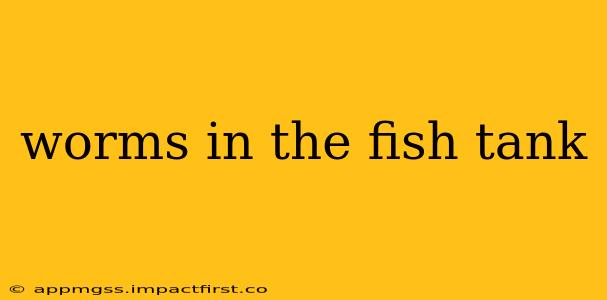Finding worms in your fish tank can be alarming, but it's a surprisingly common problem with various causes and solutions. This comprehensive guide will help you identify the culprits, understand why they appear, and effectively eradicate them to maintain a healthy aquarium environment for your fish.
What Kinds of Worms Are in My Fish Tank?
This is the crucial first step. Different worms require different approaches. Common culprits include:
- Planaria: These flatworms are usually small, ranging from a few millimeters to a centimeter in length, and are often light brown or black. They're scavengers and generally not a huge threat unless their population explodes.
- Rhabdocoela: Similar in appearance to planaria, these flatworms can also become a nuisance if their numbers grow unchecked.
- Nematodes: These roundworms are microscopic and often difficult to see without magnification. They can infest the substrate or even live within your fish.
- Tubifex worms: These are reddish-brown worms that live in the substrate and are often considered a beneficial part of the ecosystem, serving as a food source. However, overpopulation can indicate poor water quality.
- Blackworms: These are larger than tubifex worms and are often used as a food source for fish. Similar to tubifex worms, overpopulation indicates an issue.
Identifying the specific worm is key to effective treatment. A clear photo shared with an experienced aquarist or online forum can significantly aid identification.
How Did Worms Get Into My Fish Tank?
Worms can enter your tank in several ways:
- Live plants: Plants purchased from a store may harbor worm eggs or larvae.
- Infected fish: A new fish can introduce worms into your established tank.
- Uneaten food: Leftover food provides a breeding ground for worms.
- Poor water quality: High levels of organic waste create a hospitable environment.
- Substrate: The substrate itself can contain worm eggs or larvae.
How to Get Rid of Worms in Your Fish Tank?
Treatment depends entirely on the type of worm. However, several general approaches are commonly used:
- Improve Water Quality: Regular water changes (25-50% weekly) are vital. Ensure proper filtration and aeration. A clean tank is the first line of defense against worm infestations.
- Reduce Uneaten Food: Feed your fish only what they can consume within a few minutes. Remove any uneaten food promptly.
- Treat with Medication: Specific medications are available for certain types of worms. Always research and follow the instructions carefully, as some medications can harm your fish. Consult a local fish store or online forum for advice tailored to the specific worm you've identified.
- Remove Substrate (If Necessary): In severe cases, replacing the substrate may be necessary. Thoroughly clean the tank and any decorations before adding new substrate.
Are Worms Harmful to My Fish?
Many worms are harmless scavengers, playing a small part in the aquarium ecosystem. However, an overpopulation of any worm species can:
- Compete with fish for food: Leading to malnutrition in fish.
- Produce excess waste: Further deteriorating water quality.
- Infest fish directly: Some worms can parasitize your fish.
A large worm population is always a cause for concern.
What Can I Do to Prevent Worms in the Future?
Prevention is always better than cure:
- Quarantine new fish: Isolate new fish for a few weeks before introducing them to your main tank.
- Thoroughly clean new plants: Wash plants thoroughly before adding them to the tank.
- Maintain excellent water quality: Regular water changes and proper filtration are crucial.
- Don't overfeed: Only feed your fish what they can consume in a few minutes.
By understanding the different types of worms, their causes, and effective treatment strategies, you can maintain a healthy and thriving aquarium environment for years to come. Remember, careful observation and prompt action are key to preventing and treating worm infestations.
